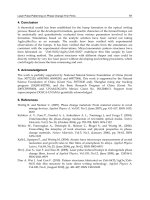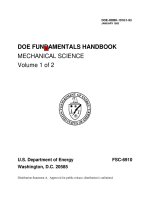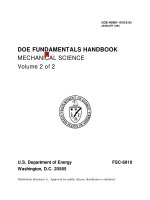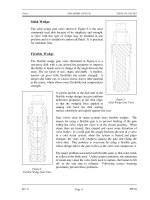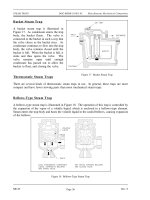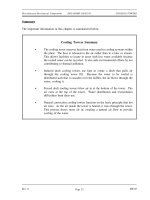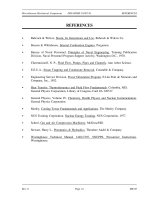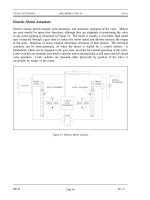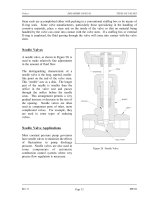Mechanical Science HandbooksMechanical Science Handbooks 20000 Part 6 pps
Bạn đang xem bản rút gọn của tài liệu. Xem và tải ngay bản đầy đủ của tài liệu tại đây (167.9 KB, 11 trang )
VALVE ACTUATORS DOE-HDBK-1018/2-93 Valves
Electric Motor Actuators
Electric motors permit manual, semi-automatic, and automatic operation of the valve. Motors
are used mostly for open-close functions, although they are adaptable to positioning the valve
to any point opening as illustrated in Figure 33. The motor is usually a, reversible, high speed
type connected through a gear train to reduce the motor speed and thereby increase the torque
at the stem. Direction of motor rotation determines direction of disk motion. The electrical
actuation can be semi-automatic, as when the motor is started by a control system. A
handwheel, which can be engaged to the gear train, provides for manual operating of the valve.
Limit switches are normally provided to stop the motor automatically at full open and full closed
valve positions. Limit switches are operated either physically by position of the valve or
torsionally by torque of the motor.
Figure 33 Electric Motor Actuator
ME-04 Rev. 0
Page 46
Valves DOE-HDBK-1018/2-93 VALVE ACTUATORS
Pneumatic Actuators
Figure 34 Pneumatic Actuator
Pneumatic actuators as
illustrated in Figure 34 provide
for automatic or semi-
automatic valve operation.
These actuators translate an air
signal into valve stem motion
by air pressure acting on a
diaphragm or piston connected
to the stem. Pneumatic
actuators are used in throttle
valves for open-close
positioning where fast action is
required. When air pressure
closes the valve and spring
action opens the valve, the
actuator is termed direct-
acting. When air pressure
opens the valve and spring
action closes the valve, the
actuator is termed reverse-
acting. Duplex actuators have
air supplied to both sides of
the diaphragm. The
differential pressure across the
diaphragm positions the valve
stem. Automatic operation is
provided when the air signals
are automatically controlled by
circuitry. Semi-automatic
operation is provided by
manual switches in the
circuitry to the air control
valves.
Hydraulic Actuators
Hydraulic actuators provide for semi-automatic or automatic positioning of the valve, similar to
the pneumatic actuators. These actuators use a piston to convert a signal pressure into valve
stem motion. Hydraulic fluid is fed to either side of the piston while the other side is drained
or bled. Water or oil is used as the hydraulic fluid. Solenoid valves are typically used for
automatic control of the hydraulic fluid to direct either opening or closing of the valve. Manual
valves can also be used for controlling the hydraulic fluid; thus providing semi-automatic
operation.
Rev. 0 ME-04
Page 47
VALVE ACTUATORS DOE-HDBK-1018/2-93 Valves
Self-Actuated Valves
Self-actuated valves use the system
Figure 35 Solenoid Actuated Valve
fluid to position the valve. Relief
valves, safety valves, check
valves, and steam traps are
examples of self-actuated valves.
All of these valves use some
characteristic of the system fluid to
actuate the valve. No source of
power outside the system fluid
energy is necessary for operation
of these valves.
Solenoid Actuated Valves
Solenoid actuated valves provide
for automatic open-close valve
positioning as illustrated in
Figure 35. Most solenoid actuated
valves also have a manual override
that permits manual positioning of
the valve for as long as the
override is manually positioned.
Solenoids position the valve by
attracting a magnetic slug attached
to the valve stem. In single
solenoid valves, spring pressure
acts against the motion of the slug
when power is applied to the
solenoid. These valves can be arranged such that power to the solenoid either opens or closes
the valve. When power to the solenoid is removed, the spring returns the valve to the opposite
position. Two solenoids can be used to provide for both opening and closing by applying power
to the appropriate solenoid.
Single solenoid valves are termed fail open or fail closed depending on the position of the valve
with the solenoid de-energized. Fail open solenoid valves are opened by spring pressure and
closed by energizing the solenoid. Fail closed solenoid valves are closed by spring pressure and
opened by energizing the solenoid. Double solenoid valves typically fail "as is." That is, the
valve position does not change when both solenoids are de-energized.
One application of solenoid valves is in air systems such as those used to supply air to pneumatic
valve actuators. The solenoid valves are used to control the air supply to the pneumatic actuator
and thus the position of the pneumatic actuated valve.
ME-04 Rev. 0
Page 48
Valves DOE-HDBK-1018/2-93 VALVE ACTUATORS
Speed of Power Actuators
Plant safety considerations dictate valve speeds for certain safety-related valves. Where a system
must be very quickly isolated or opened, very fast valve actuation is required. Where the
opening of a valve results in injection of relatively cold water to a hot system, slower opening
is necessary to minimize thermal shock. Engineering design selects the actuator for safety-
related valves based upon speed and power requirements and availability of energy to the
actuator.
In general, fastest actuation is provided by hydraulic, pneumatic, and solenoid actuators.
However, solenoids are not practical for large valves because their size and power requirements
would be excessive. Also, hydraulic and pneumatic actuators require a system for providing
hydraulic or pneumatic energy. The speed of actuation in either case can be set by installing
appropriately sized orifices in the hydraulic or pneumatic lines. In certain cases, the valve is
closed by spring pressure, which is opposed by hydraulic or pneumatic pressure to keep the
valve open.
Electrical motors provide relatively fast actuation. Actual valve speed is set by the combination
of motor speed and gear ratio. This combination can be selected to provide full valve travel
within a range from about two seconds to several seconds.
Valve Position Indication
Operators require indication of the position of certain valves to permit knowledgeable operation
of the plant. For such valves, remote valve position indication is provided in the form of
position lights that indicate if valves are open or closed. Remote valve position indication
circuits use a position detector that senses stem and disk position or actuator position. One type
of position detector is the mechanical limit switch, which is physically operated by valve
movement.
Another type is magnetic switches or transformers that sense movement of their magnetic cores,
which are physically operated by valve movement.
Local valve position indication refers to some visually discernable characteristic of the valve that
indicates valve position. Rising stem valve position is indicated by the stem position. Nonrising
stem valves sometimes have small mechanical pointers that are operated by the valve actuator
simultaneously with valve operation. Power actuated valves typically have a mechanical pointer
that provides local valve position indication. On the other hand, some valves do not have any
feature for position indication.
Rev. 0 ME-04
Page 49
VALVE ACTUATORS DOE-HDBK-1018/2-93 Valves
Summary
The important information in this chapter is summarized below.
Valve Actuators Summary
Manual actuators are the most common type of valve actuators. Manual actuators
include handwheels attached to the valve stem directly and handwheels attached
through gears to provide a mechanical advantage.
Electric motor actuators consist of reversible electric motors connected to the
valve stem through a gear train that reduces rotational speed and increases torque.
Pneumatic actuators use air pressure on either one or both sides of a diaphragm
to provide the force to position the valve.
Hydraulic actuators use a pressurized liquid on one or both sides of a piston to
provide the force required to position the valve.
Solenoid actuators have a magnetic slug attached to the valve stem. The force to
position the valve comes from the magnetic attraction between the slug on the
valve stem and the coil of the electromagnet in the valve actuator.
ME-04 Rev. 0
Page 50
Department of Energy
Fundamentals Handbook
MECHANICAL SCIENCE
Module 5
Miscellaneous Mechanical Components
Miscellaneous Mechanical Components DOE-HDBK-1018/2-93 TABLE OF CONTENTS
TABLE OF CONTENTS
LIST OF FIGURES iv
LIST OF TABLES vi
REFERENCES vii
OBJECTIVES viii
AIR COMPRESSORS 1
Introduction 1
Reciprocating Compressors 1
Rotary Compressors 4
Centrifugal Compressors 6
Compressor Coolers 6
Hazards of Compressed Air 7
Summary 8
HYDRAULICS 10
Introduction 10
Pressure and Force 10
Hydraulic Operation 11
Hazards 12
Summary 13
BOILERS 14
Introduction 14
Boilers 14
Fuel Boiler Components 16
Summary 17
COOLING TOWERS 18
Purpose 18
Induced Draft Cooling Towers 19
Forced Draft Cooling Towers 21
Natural Convection Cooling Towers 21
Summary 23
Rev. 0 Page i ME-05
TABLE OF CONTENTS DOE-HDBK-1018/2-93 Miscellaneous Mechanical Components
TABLE OF CONTENTS (Cont.)
DEMINERALIZERS 24
Purpose of Demineralizers 24
Demineralizers 24
Single-Bed Demineralizers 24
Single-Bed Regeneration 25
Mixed-Bed Demineralizer 26
Mixed-Bed Regeneration 26
External Regeneration 28
Summary 29
PRESSURIZERS 30
Introduction 30
General Description 31
Dynamic Pressurizers 31
Construction 31
Operation 33
Summary 34
STEAM TRAPS 35
General Operation 35
Ball Float Steam Trap 35
Bucket Steam Trap 36
Thermostatic Steam Traps 36
Bellows-Type Steam Trap 36
Impulse Steam Trap 37
Orifice-Type Steam Trap 38
Summary 39
ME-05 Page ii Rev. 0
Miscellaneous Mechanical Components DOE-HDBK-1018/2-93 TABLE OF CONTENTS
TABLE OF CONTENTS (Cont.)
FILTERS AND STRAINERS 40
Introduction 40
Cartridge Filters 40
Precoat Filters 42
Backwashing Precoat Filters 43
Deep-Bed Filters 44
Metal-Edge Filters 45
Strainers 45
Backwashing 46
Summary 47
Rev. 0 Page iii ME-05
Miscellaneous Mechanical Components DOE-HDBK-1018/2-93 LIST OF FIGURES
LIST OF FIGURES (Cont.)
Figure 21 Cartridge Filter 41
Figure 22 Deep-Bed Filter 44
Figure 23 Y-strainer 45
Figure 24 Common Strainers 46
Rev. 0 Page v ME-05
